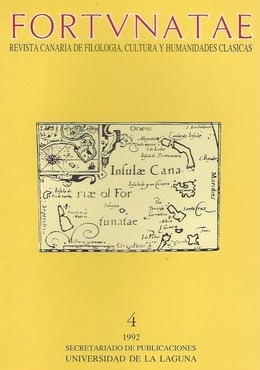El caso dativo en griego
Resumen
The dative case is not a syncretic one in Ancient Greek. It appears to be no basis for reconstructing locative and instrumental cases in prehistorical Greek. The nominal declension of the Mycenaean tablets must be considered in the light of that typological rule: the plural number cannot make functional differences, if these are not previously in the singular. The Mycenaean and Homeric ending -phi does not represent a true and autonomous case form, but a polysemic and paraflectional suffix. The so-called instrumental -ablative case of the Mycenaean tablets is a debatable one and the so-called dative-ablative of Arcado-Cypriot is not at all an outcome of syncretism.
Citas
ADRADOS (1989), «¿Sincretismo de casos en micénico?», Minos 24, págs. 169-187.
ADRADOS (1990), «El genitivo temático en -o del micénico y el chipriota», págs. 175-181 de Studia Indogermanica... in honorem A. Tovar et L. Michelena, ed. F. Villar, Salamanca.
BADER (1991) «Problématique du génitif thématique sigmatique», BSL 81, págs. 89-157.
BARTONEK (1987), «The Vocalic/Diphtongal Stems of the 3rd. Declension in Mycenaean» Minos 20-22, págs. 61-68.
CHANTRAINE (1961), Mmphologie historique du grec. París, 2a ed.
COLEMAN, R. (1987), «Early Greek Syncretism and the Case of the Disappearing -phi» Minos XX-XXII, págs. 113-125.
DORIA, M. 1968, «Strumentali, ablativi e dativi plurali in miceneo: alcune precisazioni», págs. 764-780 de Atti e Memorie del 10 Congresso Internazionale di Micenologia (Roma 1967).
GALLAVOTTI, C. (1965 (1966)), «Quelques remarques de morphologie», págs. 180-190 de Proceedings of the Cambridge Colloquium on Mycenaean Studies. Edd. Palmer & Chadwick, Cambridge 1966.
GARCÍA RAMÓN, J.L. (1984), «El micénico: 1972-1983», págs. 239-274 de Actualización científica en Filología Griega, ed. A. Martínez, Madrid.
HETTRICH, H. (1985), «Zum Kasussynlcretismus im Mykenischen» Festgabeflir K Hoffmann III (MSS 46), págs. 111-122.
HEUBECK, A. (1978), «Zu den homerischen Dativ-Singular-Formen s-stámmigen Substantiva», MSS 37, págs. 69-76.
ILIEVSKI (1970), «II sincretismo dei casi in miceneo (é sincretizzato lo instumentale con il dativo?) SMEA 12, págs. 88-116.
KURYLOWICZ (1964), The Inflectional Categories of Indoeuropean. Heidelberg.
LEJEUNE, M. Mémoires de Philologie Mycénienne. Premiére Série, Paris 1958. Deuxiéme Série, Roma 1971. Troisiéme Série, Roma 1972.
LEJEUNE, M. (1957), «La désinence -t en mycénien» BSL 52, págs. 170-201 (=Mémoires I, 1958, págs. 159-184).
LEJEUNE, M. (1965a), «Restauration analogique de la sifflante intervocalique» BSL 60, págs. 1-7 (=Mémoires III, 1972, págs. 157-162).
LEJEUNE, M. (1965b), «Flexions thématique et athématique» BSL 60, págs. 7-12 (=Mémoires III, 1972, págs. 165-169).
LEJEUNE, M. (1968a), «Position du Grec Mycénien», Atti Roma, págs. 726-732 (= Mémoires III, 1972, págs. 217-222).
LEJEUNE, M, (1968b), «L'instrumental pluriel thématique» RPh 42, págs. 219-229 (=Mémoires III, 1972, págs. 255-266).
LURAGHI, S. (1984), «Note sul sistema preposizionale dell' arcado-cipriota» Aevum 58, págs. 13-19.
LURIA, S. (1957), «Über die Nominaldeklination in den mykenischen Inschriften» PP 12, págs. 321-332.
MEILLET (1937), Introduction á l'étude comparative des langues indo-européennes. 8a ed., París (Reimpr. Alabama 1964).
MORALEJO, J.J. (1984), «"Dativo" de plural en griego antiguo» ATHLON (Homenaje a F. R. Adrados), págs. 339-364. MORPURGO-DAVIES, A. (1960), «Il genitivo miceneo e il sincretismo dei casi» RAL 8,15, págs. 33-61.
MORPURGO-DAVIES, A. (1964), «SEG XI, 1112 e il sincretismo dei casi in Arcado-Cipriota» PP 19, págs. 346-354.
MORPURGO-DAVIES, A. (1966), «An Instrumental Ablative in Mycenaean?» págs. 191-202 de Proceedings of the Cambridge Colloquium on Mycenaean Studies. Edd. Palmer & Chadwick, Cambridge 1966.
MORPURGO-DAVIES, A. (1988), «Mycenaean and Greek Language», págs. 75-125 de MORPURGO, A. et DUHOUX, Y., Linear B: A 1984 Survey, Louvain-la-Neuve.
NIETO HERNÁNDEZ, P. (1987), «Un problema de la lengua homérica: la desinencia -95i» EM 55, págs. 273-306. PANAGL, 0. (1983), «Zum Synkretismus von Dativ und Locativ Singular des s-Stámme im Mykenischen», págs. 367-373 de Res Mycenaeae (Nürnberg 1981), ed. A. Heubeck, Gittingen.
RISCH, E. (1966), «Les différences dialectales dans le mycénien» págs. 150-157 de Proceedings of the Cambridge Colloquium on Mycenaean Studies. Edd. Palmer & Chadwick, Cambridge 1966. (=Kleine Schriften, págs. 451-458). RISCH, E. (1974), Wortbiklung der homerischen Sprache. 2a ed. Berlín-Nueva York.
RISCH, E. (1980), «Betrachtungen zur indogermanischen Nominalflexion» Festschrift H. Seiler, págs. 259-267 (=Kleine Schriften, págs. 730-738).
RISCH, E. (1981), Kleine Schriflen. (Edd. Etter & Looser), Berlin-Nueva York.
RISCH, E. (1986), «Die mykenische Nominalflexion als Problem der indogermanischen und griechischen Sprachwissenschaft» Sprache 32, págs. 63-73.
RIX, H. (1976), Historische Grammatik des Griechischen. Laut- und Formenlehre. Darmstadt.
RUIJGH , C.J. (1967), Études sur la grammaire et le vocabulaire du grec mycénien. Amsterdam.
RUIJGH, C. J. (1979), «La morphologie du grec» SMEA 20, págs 68-89.
SCHWYZER, E. (1939), Griechische Grammatik. Munich.
SHIPP, G.P. (1961), Essays in Mycenaean and Homeric Greek. Melbourne.
SZEMERENYI, O. (1975), «Rekonstruktion in der idg. Flexion. Prinzipien und Probleme», págs. 325-345 de Flexion und Wortbildung. Akten der V. Fachtagung der indogermanischen Gesellschaft (Regensburg 9-14 sept. 1973), Wiesbaden.
SZEMERENYI, O. (1989), Einflihrung in die vergleichende Sprachwissenschaft. 3a ed., Darmstadt.
VILLAR, F. (1974), Orígenes de la flexión nominal indoeuropea. Madrid.
VILLAR, F. (1981), Dativo y locativo en el singular de la flexión nominal indoeuropea. Salamanca.
VILLAR, F. (1985), «El Dativo temático indoeuropeo», Symbolae L. Mitxelena septuagenario oblata, ed. J. L. Melena, Vitoria, págs. 31-48.
Los autores conservan los derechos de autor y garantizan a la revista el derecho de ser la primera publicación del trabajo al igual que licenciarlo bajo una Creative Commons Attribution License que permite a otros compartir el trabajo con un reconocimiento de la autoría del trabajo y la publicación inicial en esta revista.
Los autores pueden establecer por separado acuerdos adicionales para la distribución no exclusiva de la versión de la obra publicada en la revista (por ejemplo, situarlo en un repositorio institucional o publicarlo en un libro), con un reconocimiento de su publicación inicial en esta revista.





